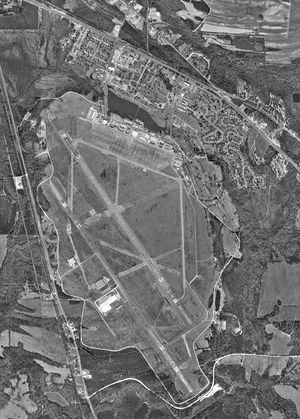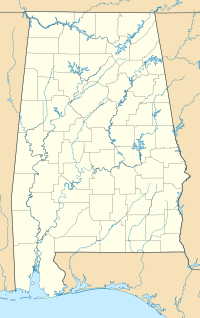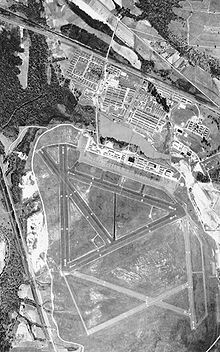- Craig Air Force Base
-
Craig Air Force Base Part of Air Training Command (ATC) Dallas County, near Selma, Alabama 
Aerial photo of Craig Field, 30 January 1998Type Air Force Base Coordinates 32°20′38″N 86°59′16″W / 32.34389°N 86.98778°W Built 1940 In use 1940-1977 Controlled by United States Air Force Garrison Air Training Command Occupants 29th Flight Training Wing (1972-1977)
3615th Flying Training Wing (1950-1972)- For the civilian use of this facility after 1977, see Craig Field Airport and Industrial Complex
Craig Air Force Base near Selma, Alabama, was a U.S. Air Force Undergraduate Pilot Training (UPT) base that closed in 1977. As an active air force base, Craig had two 8,000-foot (2,400 m) parallel runways, a large aircraft parking ramp and several large maintenance hangars.
Today the facility is a civilian airport known as Craig Field Airport and Industrial Complex (ICAO: KSEM; FAA: SEM).
Contents
Units assigned
The last unit assigned to Craig AFB was the 29th Flying Training Wing (29th FTW), being activated on 29 March 1972, absorbing the assets and personnel of the 3615th FTW.[1] Flying training squadrons of the wing were:
- 43d Flying Training Squadron - 1 July 1972 to 30 September 1977[1]
- 52d Flying Training Squadron - 1 July 1972 to 30 September 1977[2]
- 3615th Pilot Training Wing - dates unknown[3]
The 29th FTW provided undergraduate pilot training (UPT) and operated the facilities on the base. Aircraft flown by the wing were Cessna T-37s and Northrup T-38s. The last class graduated in mid-August 1977.
The 29th FTW was inactivated with the closure of the base on 30 September 1977.
History
The naming of the base was important to the nearby city of Selma, and several names for the airfield were considered. The name finally chosen was to honor 1st Lt Bruce Kilpatrick Craig, who was killed while acting as a civilian flight test engineer with the Consolidated Aircraft Company when the British LB-30 Liberator, AL503, he was on an acceptance flight in crashed into San Diego Bay on 2 June 1941. [2] He was born in Selma and was initially commissioned as an officer in the Infantry Reserve prior to transferring to the Army Air Forces and attending flight training. [4]
Origins
What would become Craig Air Force Base was established before World War II to accommodate the growing number of pilot trainees. At that time, the Army Air Corps was rapidly expanding and it was clear that additional facilities would be needed for all phases of pilot training.
Originally cotton fields and cattle-grazing land, in 1940, the city of Selma purchased the land in 1940, then leased it to the United States Government. The building of Selma Army Air Base began in August 1940, and proceeded rapidly so that by December there were about forty structures on the new base. Since there were no barracks yet available, the troops slept in tents and their headquarters was in an old cafe. By December, the runways were under construction.
Buildings on the new airfield were constructed out of a concrete block type material and featured a screened porch that ran across the length of the building. These were rather luxurious accommodations for the time. To make the grounds more attractive and the new field a bit more pleasing to the cadets, many of the mature trees were saved during the construction process.
Even though construction had just begun and the field was not ready for training, it was activated on August 4, 1940. The mission of the new airfield was the training of aviation cadets in the advanced phase of flying training. Selma AAB was assigned to the AAF Southeast Training Center, with the Army Air Force Pilot School (Advanced Single-Engine) activated (phase 3 pilot training). In this phase, the cadets flew fighters and fighter-bombers. Pilot wings were awarded upon graduation and were sent on to group combat training by First, Second, Third or Fourth Air Force. Graduates were usually graded as Flight Officers (Warrant Officers); cadets who graduated at the top of their class were graded as Second Lieutenants.
The training began in the early spring of 1941 and used two temporary runways because the permanent runways were not finished; the first runway would not be done until October. By early May there were about 53 AT-6 Texans assigned to the base along with some other aircraft. During this period, conditions were primitive, meaning that the aircraft maintenance work was done outside. By late April, parts of the parking apron had been completed and some work was being done in the main hangar. At that time most of the aircraft maintenance workers (sheet metal workers, mechanics, parachute riggers, etc.) were from Wright Field in Dayton, Ohio, and were a mixture of civilians and military personnel.
Craig Field was commanded by the 57th Army Air Force Base Unit. Army Air Force pilot training in 1941 was still considered as being peacetime and included a seventy-hour flying course. Its first graduating class of 1941, the 39 cadets of Class 41D, completed the training course seven months before the United States' entry into World War II.[5]
The Air Corps Advanced Flying School (Advanced Single-Engine) at Craig consisted of:
- 90th, 92nd, 380th, 381st and 382nd School Squadrons
- 21st Single Engine Flying Training Group (Hq & Hq Sq, 90th, 92nd SE Flyg Trng Sqs)
- 22nd Single Engine Flying Training Group (Hq & Hq Sq, 380th, 381st, 382nd SE Flyg Trng Sqs)
World War II
With the attack on Pearl Harbor on December 7, 1941 training was accelerated to speed the flow of pilots into combat.
In total Craig Field graduated more than 9,000 pilots before the end of the war. Craig Field also saw a number of British Royal Air Force cadets through their training. By 1943, 1,392 RAF cadets had earned their wings at Craig Field. In addition, French and Dutch pilots were trained at Craig Field.
On 8 January 1943, the War Department constituted and activated the 28th Flying Training Wing (Advanced Single-Engine) at Craig and assigned it to the AAF Eastern Flying Training Command.
In November 1943, Craig was selected to give advanced single engine training and Curtiss P-40 transition training to the French. Craig Field also gave training in the Martin B-26 Marauder. Many of these students had formally served in the French North African Army or had left France after the armistice and earned the opportunity to become pilots. At this time, Craig Field was also teaching fighter transition training using the Curtiss P-40. By late 1944, Craig Field was involved in three major areas of training: Advanced-Single Engine pilot training, P-40 Transition training, and a Preflight Program for French students.
During 1945, the training activities at Craig Field continued, but the classes were smaller, because of the need for fewer pilots. With the end of the war in August 1945, came the end of training of American cadets. The training of French students continued through 1945, and was ended in January 1946.
Cold War
Following the war, the mission of Craig Field changed from time to time, but it remained primarily a training base.[6] When the U.S. Air Force was established as a separate service in 1947, Craig Field was renamed Craig Air Force Base. With the desperate need for additional pilots created by the Korean War, Craig AFB was once again placed in the pilot training business by initiating the 3615th Pilot Training Wing in September 1950. The program stopped its basic single engine training and focused its efforts on pilot instructor training.[7]
In 1953, Craig AFB stopped its basic single engine training and focused its efforts upon pilot instructor training. By 1966, Craig AFB was an undergraduate pilot training base (UPT).
In 1972, the by then-3615th Flying Training Wing was redesignated as the 29th Flying Training Wing (29 FTW) of the Air Training Command and operated T-41, T-37 and T-38 training aircraft.
Representative of the time, Undergraduate Pilot Training Class 68-H, "The Haranguers," graduated with more than 50 new pilots in June 1968. Most of the pilots entered the "pipeline" for assignments to Vietnam in a variety of aircraft, including the F-4C, F-4E Phantom II, RF-4C Phantom II, C-47, C-7 and C-123. Other pilots went to C-130, C-141, B-52 and KC-135 assignments. In addition to Air Force student pilots, the class included students from the Marine Corps, the Air National Guard and the former Imperial Iranian Air Force.
Closure
In 1974, Craig AFB was selected as one of two UPT bases to be closed in a post-Vietnam economic move. In 1977, Air Training Command closed Craig Air Force Base along with Webb Air Force Base in Texas. Craig's 29th Flying Training Wing was inactivated on September 30, 1977 and the field was placed on caretaker status the next day.[8]
Current use
After the base closed, the airfield was converted into a civil airport for Selma, Alabama and renamed the Craig Field Airport and Industrial Complex.
See also
References
 This article incorporates public domain material from websites or documents of the Air Force Historical Research Agency.
This article incorporates public domain material from websites or documents of the Air Force Historical Research Agency.- ^ Ravenstein, Charles A. (1984). Air Force Combat Wings Lineage and Honors Histories 1947-1977. Maxwell AFB, Alabama: Office of Air Force History. ISBN 0-912799-12-9.
- ^ http://www.lackland.af.mil/shared/media/document/AFD-070222-007.pdf
- Shaw, Frederick J. (2004), Locating Air Force Base Sites History’s Legacy, Air Force History and Museums Program, United States Air Force, Washington DC, 2004.
- Manning, Thomas A. (2005), History of Air Education and Training Command, 1942–2002. Office of History and Research, Headquarters, AETC, Randolph AFB, Texas ASIN: B000NYX3PCa
- ^ History of Craig Field at Craig Field Airport and Industrial Complex website
- ^ 52d Flying Training Squadron entry at Air Force Historical Research Agency
- ^ 43d Flying Training Squadron entry at Air Force Historical Research Agency
External links
Categories:- 1940 establishments
- USAAF Southeast Training Center
- Initial United States Air Force installations
- USAF Air University Installations
- Closed facilities of the United States Air Force
- Selma, Alabama
Wikimedia Foundation. 2010.




